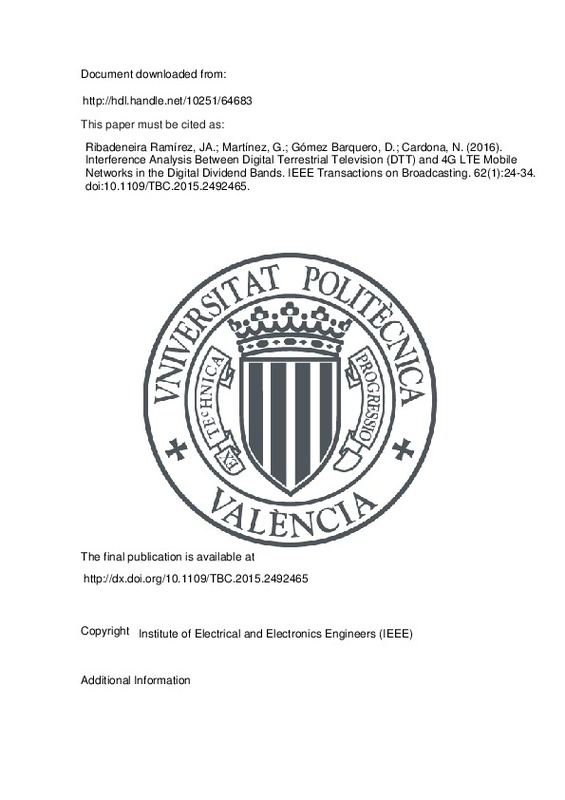JavaScript is disabled for your browser. Some features of this site may not work without it.
Buscar en RiuNet
Listar
Mi cuenta
Estadísticas
Ayuda RiuNet
Admin. UPV
Interference Analysis Between Digital Terrestrial Television (DTT) and 4G LTE Mobile Networks in the Digital Dividend Bands
Mostrar el registro sencillo del ítem
Ficheros en el ítem
| dc.contributor.author | Ribadeneira Ramírez, Jefferson Alexander
|
es_ES |
| dc.contributor.author | Martínez, G.
|
es_ES |
| dc.contributor.author | Gómez Barquero, David
|
es_ES |
| dc.contributor.author | Cardona, Narcis
|
es_ES |
| dc.date.accessioned | 2016-05-25T09:24:19Z | |
| dc.date.available | 2016-05-25T09:24:19Z | |
| dc.date.issued | 2016-03 | |
| dc.identifier.issn | 0018-9316 | |
| dc.identifier.uri | http://hdl.handle.net/10251/64683 | |
| dc.description.abstract | With the introduction of digital terrestrial television (DTT) and the analogue television switch-off, terrestrial broadcast spectrum in the UHF band is being released for mobile communications, in particular for fourth generation (4G) long term evolution (LTE) mobile services. This spectrum is known as digital dividend. An impending problem when deploying 4G LTE mobile networks in the digital dividend bands is that interferences may appear in the adjacent radio frequency channels used for DTT. In this paper, we analyze the adjacent coexistence of DTT and 4G LTE networks in the digital dividend bands at 700 MHz and 800 MHz. A generic framework is adopted such that results can be easily extrapolated to different scenarios and bands. Results are presented as a function of the guard band between technologies, for both LTE uplink and downlink adjacent to the DTT signals, and for fixed outdoor and portable indoor DTT reception. Also, the effect of using anti-LTE filters is studied. | es_ES |
| dc.description.sponsorship | This work was supported by the Spectrum Regulator of Colombia ANE (Agencia Nacional del Espectro). | en_EN |
| dc.language | Inglés | es_ES |
| dc.publisher | Institute of Electrical and Electronics Engineers (IEEE) | es_ES |
| dc.relation.ispartof | IEEE Transactions on Broadcasting | es_ES |
| dc.rights | Reserva de todos los derechos | es_ES |
| dc.subject | Digital terrestrial television (DTT) | es_ES |
| dc.subject | Terrestrial broadcast spectrum | es_ES |
| dc.subject | 4G long term evolution (LTE) | es_ES |
| dc.subject | Mobile services | es_ES |
| dc.subject | Digital Dividend | es_ES |
| dc.subject.classification | TEORIA DE LA SEÑAL Y COMUNICACIONES | es_ES |
| dc.title | Interference Analysis Between Digital Terrestrial Television (DTT) and 4G LTE Mobile Networks in the Digital Dividend Bands | es_ES |
| dc.type | Artículo | es_ES |
| dc.identifier.doi | 10.1109/TBC.2015.2492465 | |
| dc.rights.accessRights | Abierto | es_ES |
| dc.contributor.affiliation | Universitat Politècnica de València. Instituto Universitario de Telecomunicación y Aplicaciones Multimedia - Institut Universitari de Telecomunicacions i Aplicacions Multimèdia | es_ES |
| dc.contributor.affiliation | Universitat Politècnica de València. Departamento de Comunicaciones - Departament de Comunicacions | es_ES |
| dc.description.bibliographicCitation | Ribadeneira Ramírez, JA.; Martínez, G.; Gómez Barquero, D.; Cardona, N. (2016). Interference Analysis Between Digital Terrestrial Television (DTT) and 4G LTE Mobile Networks in the Digital Dividend Bands. IEEE Transactions on Broadcasting. 62(1):24-34. doi:10.1109/TBC.2015.2492465 | es_ES |
| dc.description.accrualMethod | S | es_ES |
| dc.relation.publisherversion | http://dx.doi.org/10.1109/TBC.2015.2492465 | es_ES |
| dc.description.upvformatpinicio | 24 | es_ES |
| dc.description.upvformatpfin | 34 | es_ES |
| dc.type.version | info:eu-repo/semantics/publishedVersion | es_ES |
| dc.description.volume | 62 | es_ES |
| dc.description.issue | 1 | es_ES |
| dc.relation.senia | 299398 | es_ES |
| dc.contributor.funder | Agencia Nacional del Espectro, Colombia | es_ES |







![[Cerrado]](/themes/UPV/images/candado.png)

